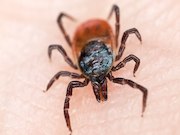
THURSDAY, July 12, 2018 — Think you live in a place that’s free from disease-carrying ticks? Don’t be so sure.
Citizen scientists found ticks capable of transmitting Lyme disease and other tick-borne illnesses in dozens of places across the United States where the pests had never previously been recorded, a new study reports.
All told, disease-carrying ticks were detected in 83 counties where they’d never been found before across 24 states.
The numbers reflect a rise in tick populations across the country, said study author Nate Nieto. He’s an associate professor with Northern Arizona University’s department of biological sciences.
“People should be aware of ticks and tick-borne disease, even when they may think there’s not a recorded incidence of a tick in a county,” Nieto said. “These things, they’re not obeying borders. They’re going by biology. If they get moved there by a deer or bird or people or pets, they’re going to establish themselves and start growing.”
The massive nationwide study also provides evidence that ticks are born carrying infectious diseases, rather than picking germs up from the animals upon which they feed, said Wendy Adams, research grant director for the Bay Area Lyme Foundation, in California.
All life stages of the most commonly encountered ticks — the deer tick, lone star tick, Gulf Coast tick and Rocky Mountain wood tick — carried the bacteria that causes Lyme disease, Adams said.
“That’s important, because that would say that a tick doesn’t need to acquire an infection from a blood meal. It’s born with the infection,” Adams explained.
These findings are the result of an unexpectedly successful effort by the Bay Area Lyme Foundation to collect tick samples from across the country.
Between January 2016 and August 2017, the foundation and Northern Arizona University offered free tick identification and testing to the general public. People were encouraged to send in ticks they found on themselves, their pets or around their communities.
The scientists’ original goal was to collect about 2,000 ticks. They wound up with more than 16,000, sent in by people from every state except Alaska.
“We got such a phenomenal participation,” Nieto said. “Two weeks in May, we got almost 2,000 packages per week. That is just powerful data.”
People found ticks in areas not represented in tracking maps maintained by the U.S. Centers for Disease Control and Prevention, the researchers discovered.
Most of these new areas were right next to counties with known tick populations, Adams said.
“Ticks are spreading. Tick populations have exploded,” Adams said. “This is good data to show the extent of that. It’s a message to people that even if you think ticks aren’t a problem, they could be.”
The 24 states that contain counties with newly documented populations of deer ticks or Western black-legged ticks are Alabama, Arizona, Georgia, Illinois, Indiana, Iowa, Kansas, Kentucky, Louisiana, Michigan, Minnesota, Montana, Missouri, Nevada, North Carolina, Ohio, Oregon, South Carolina, Tennessee, Texas, Utah, Virginia, Washington and Wisconsin.
Further, ticks were found in states where they simply weren’t supposed to be, Adams said. Lone star ticks were found in California and black-legged ticks were found in Nevada, both for the first time ever.
People also found ticks carrying Babesia — microscopic parasites that infect red blood cells and cause the potentially life-threatening disease babesiosis — in 26 counties across 10 states in which the public health department does not require physicians to report cases of the disease.
The new study “highlights the geographic variability of ticks and the pathogens they carry,” said Dr. Paul Auwaerter, clinical director of infectious diseases at Johns Hopkins Medicine in Baltimore.
“Surveillance is increasingly important as we see climate and environmental changes, because we do see expanding ranges of ticks. We’ve seen that with Lyme disease. We’ve seen that with babesiosis,” said Auwaerter, president of the Infectious Diseases Society of America.
Adams agreed, suggesting that more funding should be directed to these sorts of crowd-sourced tracking efforts.
“We have to invest federal dollars to examine the spread of ticks,” she said.
In the meantime, the Bay Area Lyme Foundation suggests that people protect themselves from ticks by:
- Wearing light-colored clothes to make ticks more visible.
- Do regular tick checks after being in a tick-infested area, and shower immediately after to wash away ticks that might be crawling on you.
- Consider using tick repellents like DEET for skin and permethrin for clothing.
- Talk with your doctor if you develop any symptoms following a tick bite.
The new study was published online July 12 in the journal PLOS One.
More information
The U.S. Centers for Disease Control and Prevention has more about ticks.
Posted: July 2018
Source: Read Full Article
